Can we talk to dolphins?
The Naked Scientists are joined by marine biologist Dannielle Green, physicist Stuart Higgins, psychologist Duncan Astle and astrophysicist Carolin Crawford, to tackle your questions. This week, find out whether you can hear screams in space, how to clean a beach, and just how giant is a Giant Squid?
In this episode

05:07 - Can technology help me run faster?
Can technology help me run faster?
Chris Smith put this question to Imperial College's Stuart Higgins
Stuart - So we’re talking about the iron man suit from the movies.
You put this suit on and you can fly around and it gives you extra strength and the ability to do certain things. This is actually a really interesting area of research - people are starting to develop exoskeletons.
The idea that you have a powered framework that you can stand into that will support your body as you make certain motions and there are a couple of reasons for doing this. Some people want to use it in order to help people who do a lot of repetitive tasks. If you’re a worker in a warehouse lifting boxes everyday moving them around, then this is something that’s going to help reduce the strain on certain joints and reduce the strain on your lower back. It’s also very useful if you’ve lost certain mobility due to a stroke or something, then it can help support you and encourage you to do it.
There are a few examples around by certain companies. There are still some challenges. One of the big problems is power - everything comes back down to batteries nowadays. In order to have motion you need quite a lot of power and you need certain battery packs and that limits the amount of movement you can do at a certain time.
Actually it’s quite complicated to replicate the motion of certain joints in the body. So if you got a ball and socket joint, that motion can be quite difficult to recover in a mechanical system so how do you design a system that gives you the same range of motion but then doesn’t do things that you don’t want it to do as well?
Chris - Is that a thumbs up. Is it possible or isn’t it possible?
Stuart - It is possible and they’re on the market now. If you have £10,000 you can buy yourself a exoskeleton suit that will allow you to lift boxes more easily.
Chris - Carolin?
Carolin - But we’re not at the point of flying yet then?
Stuart - We’re not a the point of flying yet. You can get a jet pack. You can get certain jet packs and I think there are a few examples recently. My favourites the water jet pack, which still means you need a water supply pumping water down towards the ground but that does you those kind of basic capabilities.
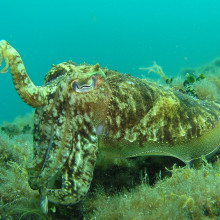
Are giant squids real?
Chris Smith asked Marine Biologist Danielle Green...
Danielle - Yeah there is actually and if you go onto youtube you can actually see some footage of the giant squid in its natural habitat. There was a documentary, I think it was 2013, where they went down in a submersible and filmed it in it’s natural habitat. It wasn’t easy to do, they tried all different techniques and ended up using other squids as bait to lure it in. It was shimmering and gold and the Professor who’s been studying his whole life for this moment was in tears - it was quite beautiful. They thought they were eight different species but recent genetic evidence has shown that there’s just one species, but they’re quite widely distributed globally.
They can get to about 14 metres long but the colossal squid is actually bigger than that and it’s heavier than that as well. That’s mostly confined to Antarctica.
Chris - The mantle and the long legs?
Danielle - Yeah. That’s the mantle and the tentacles as well - it’s heavier too.
Chris - How much do they weigh?
Danielle - They estimate that there was one that was 750 kilogrammes. That’s probably the biggest one. There are some people that think that the colossal squid and the giant squid both, both very very big, both the biggest invertebrates. There’s some evidence to suggest that there could be giant squid that are longer than that, up to 20 metres but it’s highly controversial and there’s lots of arguments going on about how big they can get.
Stuart - I found out a really crazy fact that I didn’t realise recently that some squids can change their colour. Is that something the giant squid can do - can it disguise itself and change the colour of it’s skin?
Danielle - Cuttlefish can change their colour very well. I think some squid can but I’m not sure about the giant squid - I don’t know.
Chris - They do have a relationship with a bacterium which is related to the bacteria that give us humans cholera. They can produce light and the squid have a structure on the skin which they can induce the colouration so they either feed or don’t feed the bacteria, and they can change whether or not they produce light so they can turn lights on or lights off on demand.
Danielle - Oh OK. Is that with the deep sea ones as well?
Chris - I don’t know if they’re the deep sea species.
Danielle - I bet people don’t even know yet because we actually know very little about them because it’s a difficult habitat to access and study.

09:16 - Are there white holes in space?
Are there white holes in space?
Chris asked Carolin Crawford to separate fact from fiction with this question from Stella.
Chris - So firstly, what is a white hole and would there be such a thing as collision between a white hole and a black hole?
Carolin - Let’s start off with a black hole. Lets remind everyone that’s a region of extreme gravity that comes out of Einstein’s equations of general relativity and one of the really nice mathematical things about these equations is that they’re perfectly symmetric. The same equations that predict a black hole also predict, it’s like an opposite to black hole, which is the white hole so instead of attracting things in it spits things out.
You’ve got the same mathematical equation so you end up with the same geometry of a singularity. You have what’s called the event horizon and a black hole at the point where once you cross over that you’re sucked into the black hole. With a white hole you can’t return, you get spat out once you cross that event horizon. So, so far so good.
However the catch is that symmetric in time. So when time runs forward you get a black hole, you need to run time backwards to get the white holes. So even though the mathematical equations predict it, we can’t figure out any way to get a white hole. We see astrophysical black holes on all scales all through the universe. We see nowhere anything that resembles a white hole. So it is just something that is predicted from the equations - there’s no evidence, as yet, for one existing.
Chris - Michio Kaku did a talk here in Cambridge a little while ago to coincide with a book launch he was doing and his talk was all about parallel universes. He mentioned something about the idea that you might have a black hole in one universe and the end of that black hole is a white hole, which is a big bang in the new universe. Could that be possible?
Carolin - I think once you get to that kind of speculation, anything’s possible. There are ideas that you could have an extreme rotating black hole that smears out singularity. You could perhaps fall into the black hole, miss the singularity, go through a wormhole, be spat out. Ideally a white hole in our universe, the possibility also, could be it creates a new universe, as you were saying. These are ideas and we still don't quite know how you’d be able to form one, and there’s certainly no evidence. To be honest, if you get spat out in another universe, I'm not sure we’re going to know about it in this one.
Chris - Andrew Ponson, I think it was on this show said “that with maths you can prove anything you like with theoretical physics.” So everything's up for grabs.
Carolin - It doesn’t mean something necessarily exists.

12:15 - Can I improve my memory as I get older?
Can I improve my memory as I get older?
Duncan - The first thing to say is that memory is an incredibly complex phenomena. Indeed, one of the major roles of the brain is to learn from our experience and our environment and apply that knowledge to new scenarios. But there’s been a lot of research exploring whether or not you can train people’s memories and whether that will yield improvements.
Most of that work’s being done with short term memory, or working memory. Initially there are some really exciting findings showing that you could train people’s short term memories and that would translate to benefits in wider everyday usage. And that’s spawned a whole series of brain training apps and programmes online, which you’ve probably all seen. However, that finding has been incredibly difficult to replicate.
Chris - As in, if you do these things you will improve your memory or improve your reasoning ability and so on? That sort of finding is hard to replicate, is that what you're saying?
Duncan - The original finding that was really exciting was that not only will you get better at the things that you’ve trained on, but that will also generalise to other things that you haven’t trained on.
Chris - So this is a miracle sales opportunity for people who make these games, but it’s not supported by the science!
Duncan - Yeah - kerching, kerching! My boss describes it as the “wild west” of cognition. There are people who make very strong claims about the benefits of this kind of training but, in my view and possibly the increasing consensus, is that when you look at studies that use the gold standard methods you can get very strong improvements on specific things that you train on but you won’t get wide generalisations.
Chris - Is a good way of thinking about this perhaps to say we know the study was done on the London cab drivers who learned the map of London, we saw that there was evidence of an improvement in the part of the brain, the hippocampus, where you store a map of the world. But we didn’t see every part of their brain suddenly becoming a lot larger, we saw just this discrete mapping of the world part of the brain get bigger?
Duncan - Yeah. That’s quite a nice analogy and way to think about it. Another way of thinking about it is that the way these training programmes work is that usually they’re very specific and they’re very divorced from reality, so you can have games online that don’t really bear any resemblance to real life. So one of the big moves in the training field now is to try and develop new ways of training people that are much closer to the things you actually want to improve.
For instance, with the cabbies, they got these specific gains in spatial navigation and spatial memory because they were doing it every single day. The idea is if we could design training in a better way that’s closer to the things which we’re trying to help people with, then it might be more beneficial.
Chris - Do you think this claim - patients sometimes say to me - I do the cryptic crossword every day and I know how fast I can complete it in, and I’ve got better and I think this keeps my brain agile into old age. Do you think that’s true?
Duncan - It could be true. It’s quite hard to demonstrate empirically, because empirically you have to do this very tightly controlled randomised controlled trial.
Chris - So you think people who can do the crossword, there in a selection group already?
Duncan - Yes.
Chris - They’re already pretty good so they’re much less likely to suffer problems?
Duncan - One of the studies that we have done is with people who had a stroke. Older adults, usually over 50 and who’ve had a stroke, and they’re experiencing some really quite profound attention and memory problems, which does show that there are some benefits to people like that who’ve had the current kind of training programmes. The pilot study was really quite promising in showing that there are people for whom the training could be beneficial.
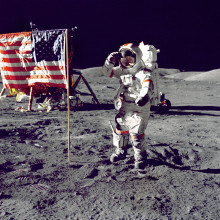
15:46 - Can a scream be heard in space?
Can a scream be heard in space?
with Carolin Crawford
As the saying goes, "In Space, no one can hear you scream"... But is it true? Chris asks Carolin Crawford to debunk this myth.
Chris - But before we jump back into your questions, let’s delve into the topic of myths which we touched on earlier. Now we love busting myths here on The Naked Scientists as regular listeners will know, and I’d like to know our panel’s favourites howlers.
For instance, I enjoy the old adage - “a strong drink puts hairs on your chest!” It did not work for me!
Carolin, have you come across any scientific howlers in you neck of the woods?
Carolin - Oh, plenty. But the one I’ve picked up out today is that phrase “in space no-one can hear you scream.” Now this is actually right, but perhaps not for the reasons people expect because sound requires a medium. So the pet answer is there’s no sound in space because space is a vacuum.
Actually, there’s plenty of sound in space because the space between the stars, and even the space between galaxies isn’t a true vacuum.
Chris - There is one atom per cubic metre or something is it?
Carolin - If you think the air in this room, probably the air molecules a thousandth of the volume. They're separated by a distance ten times their size. Once you go out is space they're separated by at least a million, ten million times their size, so there’s still a medium, it can still transmit sounds. But if you think how a sound works, you have to displace a molecule far enough that it hits another molecule, and it’s those vibrations that set up the compressions and the rarefactions that it’s a soundwave.
So in space you can transmit sounds but they’re got to be an incredibly long wavelength.
Chris - Very, very low frequency in other words?
Carolin - Very, very low frequency - yes. So, if you could remove your helmet, there are sounds in space, but you wouldn’t hear them because they’re going to be way out of the 20 to 20,000 hertz that our ears pick up.
Chris - Because our ears are sensitive from about 50 upwards to about 15,000 in an adult aren’t they, so under 50 hertz we're not going to hear it. So you’re saying these frequencies would be so low there’s no chance of hearing them?
Carolin - That’s right. And indeed, one of these sounds I have studied is in an atmosphere that’s in a whole cluster of galaxies where the frequency is one cycle every 10 million years, so that is extreme sound. There are sounds in space but it’s just but it’s just such a very different kind of atmosphere that they’re not sounds you would hear. So it’s correct but not for the reasons you might think.
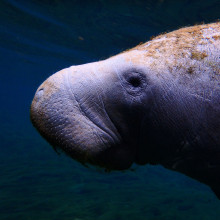
18:03 - Siren v Sea Cow: What's the difference?
Siren v Sea Cow: What's the difference?
Marine biologist, Danni Green, gets myth-busting when it comes to Sirens.
Danielle - Probably just the old sea sirens. Back in the seafaring days (1700s-1800s) there were lots of sailors that were reporting mermaids, and there were pictures of these beautiful naked women with long flowing hair luring sailors into the sea. There is some truth to that but what they were seeing weren't actually mermaids, they were sea cows.
Chris - Dugongs?
Danielle - Dugongs, yeah. There’s some pictures of the sketches of these mermaids and you can see that it does look quite a lot like a dugong, except a bit more ladylike particularly in the bosom department.
Chris - A bit of artistic licence has gone on there.
Danielle - Yeah - artistic licence. So there is some truth to it which is why they’re called serenia as well, which is siren - sirens of the sea.
Chris - It must have been a very shortsighted sailor who managed to muddle up a dugong with a mermaid because they’re quite different?
Danielle - A bit too much rum maybe.
Carolin - Well, they’d been away from home for a very long time!

19:03 - Do we really only use 10% of our brain?
Do we really only use 10% of our brain?
with Duncan Astle, University of Cambridge
The myth busting continues, how much of our brain do we use? Chris asked Duncan Astle from the University of Cambridge...
Chris - Duncan, is there anything psychological that you’d like to throw into the mix?
Duncan - So many it’s hard to know which one to choose. The classic one is you only use 10% of your brain. You use all of your brain, and even the death of cells in relatively restricted parts of the brain can result in quite profound cognitive problems.
There are loads like the left hemisphere of your brain is for logic and the right is for creativity. That’s nonsense. Sometimes people say to me some people’s brains are predisposed to learn in different ways, so we have kinesthetic learners, and auditory learners. That, I’m afraid, also is nonsense.
Chris - Dani you’re nodding is that yes because you are one or you think this is rubbish?
Danielle - As a lecturer, we’re told that a lot so we have to account for all different types of learners and that’s one of the things I learnt in my PGCE that I did quite recently. There’s four different types of learners.
Chris - You’ve just demolished all of her learning.
Duncan - I’m afraid so.
Danielle - I do tend to use a lot of visual, written, and all different things any way, so I think it’s OK.
Duncan - In that sense it’s great. What we do know is that if you deliver materials from different perspectives and in different ways, then the learning will be more durable. We’ve known that for a long time - it’s classic cognitive psychology.
But what this is suggesting is something rather different, which is that people, often children, are predisposed to learn in specific ways, and will learn best when information is delivered in their preferred style, and that is not true. You can demonstrate with the data that children are not better or worse in their preferred style and, potentially, in my experience it can be quite damaging. If you say to a child you’re a kinesthetic learner, then when the lesson is delivered in a different way, the start to think what’s the point in me paying attention. This is not in my preferred style and a waste of my time.
Danielle - It’s an excuse to go to sleep in my lectures.
Chris - Well no-one would do that surely Dani, I’m sure!
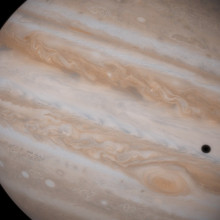
20:45 - Is Jupiter made entirely from gas?
Is Jupiter made entirely from gas?
Chris asks Caroline Crawford from the University of Cambridge to answer this listener's giant question.
Caroline - This is a very good question because Jupiter really is giant. It’s got a volume of which is equivalent to 1,300 earths. But the fact that it only weighs just over 300 times the mass of the Earth immediately tells you it’s mainly made of gas. So it’s hydrogen, helium things like that - that’s the predominant component. But we do think there's a rocky core, and maybe a rocky core that could be 10, maybe even up to 30 times the mass of the Earth all compressed down into something slightly less than the size of the Earth, right down into all that atmosphere. We can’t fly through and find out, this isn’t experiment you can do because the trouble is, if you throw a spacecraft into Jupiter, which we have done by the way, in the Galileo mission. A spacecraft goes into Jupiter - a good way to dispose of the spacecraft at the end of it’s mission.
Chris - And a comet because Shoemaker-Levy 9 plunged into Jupiter as well, didn’t it?
Carolin - What happens is when you look at the disc of Jupiter all you see is the cloud tops just in the few hundred kilometres. The gas is molecular for about 1,000 kilometres in but after that it has to carry the weight of all the overlying layers of gas and it starts to get high temperature, high pressure and becomes as incompressible as a liquid. So if you throw any spacecraft in, it’s just going to get crushed, it’s going to get destroyed really quickly, so we can’t fly in and find the rocky core or see it. We think it’s there from everything we understand about how planets form. We think you have to have a rocky core that grows quickly that can then sweep up the gas and accumulate this huge atmosphere.
But the question is how do we measure it’s size? How do we measure its mass? And this is, in fact, what we’re doing now with the Juno spacecraft that’s in orbit around Jupiter, and it’s got this 53 day orbit. On one end of the orbit it skirts to within about 4,000 kilometres of the cloud tops of Jupiter and, as it does that, it’s tracking the form of Jupiter’s gravitational field which, of course, depends on the distribution of mass within the planet. So that’s our way of tracking it and that’s one of the main things of this spacecraft - it’s got a lot of other science - one of the main things it’s trying to determine.
Dani was saying if you Google on thing tonight - go and do “tongue parasites”. Well that doesn’t quite appeal to me, especially when I’m having my dinner, but I would say go and Google “NASA Juno mission”. They put up, just in the last week, some fantastic images of some of these fly pasts of Jupiter and they are just beautiful, as well as being really interesting science, but just mesmerising.
Chris - Duncan?
Duncan - If there is a rocky core, is there any way of knowing what the rocky core is made of?
Carolin - It’s the same as all the rocky planets. So it’s going to be carbon, nitrogen, oxygen, magnesium, silicon, iron. All the normal things that make up all the rocky planets. It’s just that when Jupiter forms, it forms further out from the Sun and you’ve got all these volatile ices and molecules. That rocky core can then sweep up those and accumulate in an atmosphere in a way that the planets like Earth and Mars can’t because they haven’t got all those lightweight gases around.

23:57 - What's the smallest particle we can detect?
What's the smallest particle we can detect?
Chris asks Stuart Higgens to zoom in on this question from Katie.
Stuart - Do you know what it’s a really difficult question to answer. I had to go back to my particle physics undergraduate notes to check. It’s very difficult because in our current understanding of physics - the standard model of particle physics - we treat the fundamental elementary particles as point like. That means they don’t really have a size and that causes a whole issue of problems both conceptually, and almost potentially mathematically. What we can think of though in terms of these is what kind of size they interact with? So if we were to fire one particle into another, what’s the kind of area that they would interact with? And that’s called a cross section in particle physics.
In that case, something like a quark, which is the constituent of a proton or a neutron - very, very very, tiny. I’m going to quote John Butterworth, who’s a Professor at UCL, who said “it’s about 43 billion billionths of a centimetre.” So absolutely incredibly tiny. That’s the upper limit it could be so it could be smaller, or it may not even have a size at all.
Chris - So there you go Katie, so the answer is pretty small.

25:40 - Quiz: What kills more, sharks or selfies?
Quiz: What kills more, sharks or selfies?
Chris: But before we have any more questions, as promised we have a little quiz for our panel and for you at home…We’re going to have two teams so what we’ll do is we’ll have Dani and Stuart who are sitting next to each other - you'll be one team. And we’ll have Carolin and Duncan as the other team. So I read you a question and you have to decide it it’s right or if it’s wrong.
Chris - Duncan and Carolin, this is your first question.
Q1. What has more eyes, a dragonfly or a box jellyfish?
Carolin - A dragonfly’s only got two eyes but they’re really sort of compound eyes aren’t they? Do they count as individual?
Duncan - I don’t know. My knowledge of eyes is limited.
Carolin - This is very embarrassing because I do have a son who actually works in insect eyes, so I should know the answer to this. Do jellyfish have eyes?
Duncan - I think dragonfly.
Carolin - OK. If you can count all those little compound bits as eyes, I’ll go with dragonfly as well.
Chris - A box jellyfish is the answer! Dragonflies have two eyes, these are compound eyes, so they’re built from tens of thousands of miniature units, but the box jellyfish actually has 24.
Did you know that Dani?
Dani - I might have been thrown by the complex eyes as well. I could have been a little bit thrown, but yeah, I would have erred on the side of the jellyfish.
Chris - Discovered in 1955, Chironex fleckeri after the doctor who fished one out of the water because a young boy unfortunately died of the sting. He was found to have found a new species of jellyfish, and it was named Chironex fleckeri in his honour.
Zero for that so you’re doing well so far [giggles]
Let’s go over to Dani and Stuart
Q2. Who holds the record for smallest vertebrate (animal with a backbone) in the world... a fish or a frog?
Stuart - I’m looking at you here Dani.
Dani - I’d be tempted to go fish. I don’t know.
Stuart - I can imagine a fish being smaller than the smallest frog I can imagine. What do you reckon?
Dani - Let’s go fish.
Stuart - OK. We’re going to go fish.
Chris - It’s a frog! But only recently. The record holder until 2012 was an Indonesian fish (Paedocypris progenetica) at just under a centimetre, but then a frog (Paedophryne amanuensis) was found in Papua new Guinea that was only 7mm - tiny! There might be smaller vertebrates to find, but unfortunately they’re harder to spot.
We’re level pegging. Very high scoring round so far - zero/zero.
Back to our first team Duncan and Caroline.
Q3: Next then, what would take longer – walking once around the equator, or getting a spaceship to Mars?
Carolin - Well, it depends how fast you travel through space, doesn’t it? If you could travel at the speed of light you’d get to Mars a lot quicker than it would take you to walk round the the Earth.
Duncan - Do you mean with standard space travel methods?
Chris - Yeah.
Carolin - In a rocket it takes you six to nine months to get to Mars. You could also say it depends whether we’re on the same side of the Sun as Mars at the time.
Duncan - Oh gosh - it’s complicated.
Carolin - Yeah, it’s a kind of three dimensional problem isn’t it?
Duncan - Let’s say six to nine months to Mars from here.
Carolin - By conventional spacecraft.
Duncan - Exactly. I don’t know that I could walk round the equator of the Earth in six to nine months!
Carolin - I think it would be a challenge yes.
Chris - So what are you going for?
Carolin - Shall we say it’s longer to walk round the equator?
Duncan - Yeah.
Carolin - Especially , it would be difficult over the sea wouldn’t it?
Duncan - Yeah.
Chris - You're going for taking longer to walk round the equator.
Duncan - Yeah
Chris - Yep! Well, we’ve done some back of the envelope calculations. The equator is around 25000 miles around, if the average walking speed is 3mph that’s 8,300 hours. Assuming whoever it is doesn’t need any breaks (and can walk through water) that would take about 345 days. On the other hand, spaceships have reached Mars in 156 days. So it’s quicker to get to Mars!
Very well done. One point to Duncan and Carolin.
Dani and Stuart - here we go.
Q4: Which is the larger: number of germs in a sneeze, or trees on Earth?
Stuart - There’s a lot of trees.
Dani - But microbes are really small aren’t they? You know all about size don’t you - you're the size man!
Stuart - Cells are in the order of about 2 microns, so two thousandths of a millimetre.
Cani - And the volume of a sneeze… A litre - is it that much?
Stuart - A litre of sneeze. That’s horrible!
Dani - I’ve got hayfever. It feels like a litre today.
Stuart - But there’s all that business, if you sneeze in a tube carriage it kind of hits the back end of the tube carriage - it will go all through the train carriage.
Chris - On that pleasant thought, would you like to give me an answer? Are you going more germs or more trees?
Stuart - More germs.
Dani - We’ll go germs.
Chris - I’m afraid not it’s trees! There are thousands to millions of virus particles in an infected person’s sneeze, but a recent estimate by researchers at Yale University put the number of trees on earth at about three trillion. Although the number is going down they caution - we’re losing trees.
We might as well carry on. We might as well have the last one.
What releases more carbon dioxide, one human breath, or running a Google search?
Carolin - A google search doesn’t last very long.
Stuart - I’m just trying to think of how to quantify the amount of carbon released from a google search.
Carolin - Well, presumably the computers that are running or what you need to have..
Stuart - Electricity.
Carolin - … electricity and what you may have needed to manufacture to enable that google search. Shall we be controversial and go for the google search?
Stuart - I’ll trust you.
Carolin - Oh don’t.
Chris - So you’re going for google search releases more CO2?
Duncan - Yeah.
Chris - GOOGLE! According to Google’s own numbers, a typical search amounts to 0.0003 kWh of energy - and you’d need to emit about 0.2g of CO2 to generate that as electrical power to run their data centre. The average human, on the other hand, exhales around 1kg of carbon dioxide a day, so - at 12 breaths per minute - that works out at roughly 0.05 grams of CO2 per breath. So Google searches cost more C02 than a breath. The figure is slightly controversial because Google’s figures don’t include the carbon cost of running your own computer…
Could be a tie - are you ready. Dani and Stuart...
Q6: What kills more people – sharks… or selfies?
Dani - I want to go selfies on that. Just people of people off the side of cliffs and things isn’t it?
Stuart - A big thing recently… governments have started warning people to stop taking selfies off dangerous ledges and things.
Dani - Like a person with a selfie stick and it has a red thing through it. There’s signs telling people not to in dangerous places.
Stuart - It’s got to be selfies.
Dani - Yeah. Let’s go selfies.
Chris - Selfies. Sharks kill around 5 people a year, but in 2016 over 50 people were killed-off trying to take photos of themselves on their phones.
The winners this week beyond price - the prestige of winning the Naked Scientists fact or fiction quiz this week is Duncan and Carolin. Very well done.
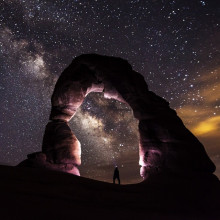
Is there such a thing as a green star?
Chris put this question to Carolin Crawford...
Carolin - Well, this is a very interesting question because some people are always amazed to know that stars have colours. If you stand out in your back garden and you look with your naked eye they all look white, except one or two like Beetlejuice maybe look vaguely orange. If you look through a telescope you begin to see a few more colours and, obviously, if you have pictures taken with a digital camera those colours begin to pop out. You see there are blue stars, and yellow stars, and red stars, and white stars but yet, curiously, there aren’t any green stars, and the colour of stars is related to their temperatures. So in the same way that you heat a lump of metal up it’s starts glowing this sort of dull red, it goes through to orange, and at it’s hottest a bright almost blue/white. The same with stars, they are glowing because they are hot - it’s thermal radiation. In physics your red is cool and blue is hot.
But if you could analyse the spectrum, in other words you look at the distribution of light given off by stars, they’re not just giving off that one colour, they’re giving off a whole range of colours. It’s something called the black body radiation. If you could map it out, it would look like a spread of all colours but with a definite peak. So with a cool star that peak is in the red, so the red light dominates. As the star heats up that peak shifts through to the blue. So if you get a star at 3,000 degrees it’s very cool and red, at 30,000 degrees it’s stonkingly blue.
Now what is curious is if you get a star like our Sun (about 6,000 degrees) that peak is bang in the middle of the visible spectrum. The difference is you’ve got that peak, that’s where most of the light comes out but if you’re right in the middle of the spectrum you’ve got as much yellow light and as much blue light to either side. So your eye kind of mixes it together and sees white. But if that peak is at one end, so either at the red or the blue, you’re just seeing that peak and one side of the colour so you don’t get so much mixing. So even though our Sun predominantly gives off most of it’s light green, we’ve got all this yellow and blue next to it and it get’s mixed out as white.
Chris - Dani?
Dani - I was just going to ask does the colour give any indication, and does the temperature give any indication of the life span? Are the really hot ones about to explode or is it not as simple as that?
Carolin - It is very, very clever because the temperature tells you how hot the star is, which in turn tells you how massive the star is, and also how old it is. We learn all this just from taking spectral images of stars and we can work out all these things. It’s kind of perverse because if you have a really hot star, it has to burn energy at such a rate because it’s a really massive star. So a stars life is just basically a battle against gravity. If you have a really massive star, it’s going to burn that much hotter, it’s going to go through it’s fuel that much quicker to withstand gravity. However, even though it’s a bigger star it goes through it’s fuel faster and so it has a shorter life. So if you see a bright blue star, it’s a really young star and it’s a really massive star. If you see a very cool dim red star, that’s actually going to have a lifespan of billions of years unlike the hot blue star which is perhaps millions of years, so you can learn an awful lot from the colour.

36:37 - Are women better multi-taskers than men?
Are women better multi-taskers than men?
Duncan Astle gets to the bottom of this...
Duncan - The bottom line really with any kind of cognitive task is the more you practice it, the better you get. I see no reason that would be different with multitasking. You can train it, people will get better at multitasking.
Whenever I give a talk people often ask about gender differences. In any of our datasets we tend to find that there are very, very few gender differences and, as far as I know, there are no gender differences in multitasking.
Chris - Where does this idea come from because it’s very pervasive - it’s commonly said?
Duncan - There are all sorts of gender stereotypes that are incredibly pervasive. In 2014 there was a paper in Proceedings of the National Academy of Sciences where they scanned the brains of 500 men and 500 women. They used a type of science called network science which is looking at how different areas of the brain or organised and how they are connected with each other, and they identified some differences between the two groups and genders.
On that basis they said that must be why women are such good social communicators, where men are really good at perception and action tasks. Of course, they didn’t have any data to suggest that that was true, and there’s a real risk that when you identify any differences in the brain that you use that to peddle some kind of gender stereotype.
It’s like me saying I’ve surveyed everyone in this room and the men, on average, are 10cms taller. That must be why men are such great leaders. Well, we’ve got no evidence that that’s true anyway. So I think that’s often why these things become so pervasive because it’s just a way of peddling well entrenched stereotypes.
Chris - So beware of the stereotypes. Is there any way of getting better at multitasking if you’re not good at it to start with? Is there various techniques that one could employ to improve that?
Duncan - Well, I’ve never tried it, but the bottom line with cognition is that practice makes perfect, so get masses of practice, even on very complicated tasks. Whether it generalises to other sorts of multitasking is a bit of a grey area.

38:47 - What's the best way to clean up a beach?
What's the best way to clean up a beach?
Marine biologist Danni Green tell Chris how we can boost our beaches.
Danni - I think the first place you could start is to get involved with a local coast watch/litter watch group and go out and collect litter and marine anthropogenic debris, so most of that would be plastic.
In terms of beach regeneration and replanting of angiosperms, and algae, and things like that, it’s a lot more complicated and difficult, and there’s been a lot of work done on this. I’m assuming the beach he’s talking about used to have seagrass in the first place, because if it didn’t, you shouldn’t really go in and mess with a habitat - it is what it is. If it’s a sandy beach it’s a sandy beach and if it doesn’t have seagrass on it that’s fine.
A lot of the seagrass beds have been destroyed by people and the quality of these habitats have been degraded. They’re really important nursery grounds, they’re really important for ecosystem services, and ecosystem functioning.
In terms of restoration, there was a meta analysis about this recently that found that the most important thing you can do with restoration of seagrass habitats is to make sure that the habitat is in a good state already, so making sure there’s not a lot of litter and other pollutants. So you clean it up first and then you replant, and you want to replant in quite a big quantity, so I’m not sure that one person on their own could do this. This is something that you need a whole team to do. They found that the larger quantity that you replant, and if you also replant with a lot of genetic diversity, then you’ve got a greater chance of the survival of the shoots, increased productivity, biomass, and healthier seagrass.
Chris - There was a paper came out quite recently showing that if you have these seagrasses they seem to have some kind of sterilizing effect on the water, in terms of pathogen sterilization. They remove bacteria which we would regard as harmful, as pathogens, from the water, and the levels of these pathogens in areas where there were no seagrasses were perhaps an order of magnitude higher.
Danni - Oh OK, I’ve not actually seen that. I wonder if that’s because of the microbial communities on the actual seagrass itself?
Chris - They said they don’t know and they speculate that it appears that perhaps the microbiome on the plant is influencing things. Or that the other species which are attracted to live in the seagrasses themselves have some kind of anti-microbial, anti-pathogen effect.
Danni - And in the sediment beneath the seagrasses as well. Because they’re one of the few marine plants that are going to create a complex habitat beneath the surface of the sediment too.
Chris - But the bottom line is if we mess the environment up, we do so at our peril and we probably need to be a lot more careful about better stewardship of our planet don’t we really, that’s the bottom line?
Danni - Yes. I think that’s definitely true. I think it’s very good that people are asking these questions too.

41:42 - What happens to old spacecrafts?
What happens to old spacecrafts?
Stuart and Carolin answer a question from Tony that's out of this world
Stuart - It depends if we’re talking about spacecraft such as satellites then you’ve got a couple of choices. You can do the fun thing, which we talked about a little bit earlier which is to dive bomb the back into a planet or into a star. You can bring them back into the Earth’s atmosphere and, most of the time, the majority of satellite will break up as it burns up and gets very hot. If you’re unlucky maybe a few fragments will make it back down to the ground.
The other option is to stick into what’s called a graveyard orbit. You can put them about 200 miles higher up than the active satellites, so about 22,400 miles above the Earth. The idea is basically to put them out of the way. This is a really big problem because we’ve put so many satellites into space, and so many satellites orbiting the Earth that all that rubbish is starting to get in the way. Because these things are moving so quickly and so fast that the impacts of these parts of debris of systems cause huge problems with existing and active satellites that are out there. So it’s something you really have to take care of nowadays.
Chris - Because the particles are whizzing round at ludicrously high speeds and energies, aren’t they? So if you happen to be on a space walk or something it could tear through your spacesuit, it could tear through your spacecraft?
Stuart - Yeah. It’s a huge danger to the International Space Station. If you’ve got a small millimeter size particle doing a thousand kilometres and hour that can go through the side of shielding or something, that’s a big problem.
Chris - Even faster than that in some cases isn’t it Carolin? Some of the particles are moving very, very fast.
Carolin - The space station itself is going about 8 kilometres a second - phenomenal speed. I will just say though, space stations are in quite a relatively low Earth orbit so anything that’s orbiting at that height, if it’s not being continually boosted, will decay and burn up. One of the most recent examples was the astronaut who let go of her toolkit by accident and it drifted away from the spacestation. I can’t remember how many weeks later, but people could actually see her toolkit burn up in space because in orbit it had decayed and then it reached the atmosphere.
At the height of the International Space Station, there is junk around and you're relatively safe. But further up we’re just getting cluttered and you have the immense danger of things colliding. You get this breakaway thing where you have these high impact collisions, bits fly off that are more likely to impact other satellites, and it could be disastrous.
Chris - The height of the International Space Station - 150 kilometers or so up isn’t it - it’s not very high?
Carolin - A bit higher than that, probably about more 350/400 kilometres. Space starts at about 100 kilometres roughly.
Stuart - Every time a supply ship comes up and it docks at the International Space Station they have to boost it a little bit higher to stop it coming back into the Earth’s atmosphere.
Chris - It gives it a bit of momentum to speed it up?
Carolin - Yeah, just a little push.
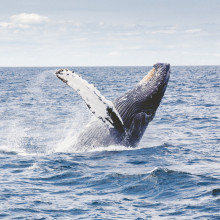
44:23 - Why do beached whales sometimes explode?
Why do beached whales sometimes explode?
Chris Smith askled Anglia Ruskin's Danielle Green...
Dani - The reason that they explode and, actually, they don’t explode as often as people think that they do. There have been some horrendously documented cases of it on youtube because it does happen, unfortunately, sometimes. Basically the microbes in their bodies and their guts are still degrading them and this is releasing gas. They’ve got very thick skin so that this gas isn’t easily released from the body, so they will bloat up and sometimes they can explode. Sometimes they explode because people are jumping on them, so never a wise thing to do - not a good idea.
What are they doing on the beach in the first place? Whale strandings are quite a common phenomenon and there’s a lot of evidence to suggest different theories. There are natural things that can lead to this, so disturbances in the weather. Sometimes, smaller whales like pilot whales will be herded in by large predatory whales like killer whales and they’ll end up being stranded on the beach.
Unfortunately, there’s quite a bit of recent evidence to suggest that it’s anthropogenic noise, so that’s noise made by people. The ocean’s an extremely noisy place anyway, but there’s a lot of evidence that sonar from military operations is affecting the navigation systems because the whales use echolocation. And there's correlations between them coming up from the deep too quickly and developing decompression sickness as well and they can get hemorrhaging from really loud noises. Some of the noises used by military and boats are extremely loud (hundreds of decibels) and they can actually get hemorrhaging in their ears, and they use their ears to echolocate so this can put them off kilter and they’ll become stranded. So there’s quite a lot of evidence that human noise could be an issue as well, but there are natural reasons too.
Chris - Weren't you saying something, Duncan, about people actually dynamiting these whales? Not before they’re dead, obviously, but when they’re on the beach to get rid of them and clear up the mess.
Duncan - That is what I naively believed. Before you just gave that answer I thought it’s just an efficient way of disposing of a very large whale. Just blow it up and then seabirds and so on will eat it.
Chris - Because that would make quite a stink.
Carolin - I wouldn’t be surprised.
Duncan - That’s just what I thought was true. I’ve no evidence to base that on whatsoever, and I’m so glad that you’ve put me straight.
Carolin - The humble microbe strikes again.
Chris - I think, taking a historical perspective for a minute, Henry VIII wasn’t quite whale size but he was getting there towards the end of his life, and I think it was a very hot day when he died. The history books, and I think people will bear me out on this, he did explode for a very similar reason. As you say, he fermented internally and there was a pocket of gas that built up and Henry VIII was no more.
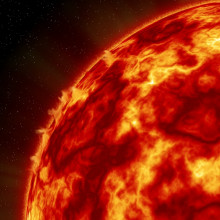
47:09 - How do we know that the sun rotates on its own axis?
How do we know that the sun rotates on its own axis?
Carolin - Yes, it does rotate. It rotates around an upright axis about once every four weeks and the first person to realise this was Galileo. How you know something rotates is you look at a fixed feature on it’s surface and you wait and you time how long it takes for that feature to come back into the field of view.
Normally when you look at the Sun, and this is not a recommended practice I hasten to add, there are not features. But he used his telescope to project images of the Sun and he saw sunspots for the first time and these were just like little black specks...well little - they’re bigger than the size of the Earth, they’re tens of thousands of kilometres across… they just look tiny on the surface of the Sun. These are slightly cooler, they’re slightly darker and they rotate with the Sun. So he tracked how those progressed across the disc of the Sun and worked out the Sun rotated about every four weeks.
However, it isn’t a solid body. So, even though the Sun rotates, it’s not like a planet where every bit on the surface rotates at the same rate and, in fact, the Sun shows something called differential rotation. Indeed, this is why we know it’s made of plasma rather than a solid thing. The Sun rotates unevenly and it changes with the latitude, and at the poles it takes ten days longer than it takes at the equator.
Chris - Does that mean it tangles itself up almost? It sort of screws itself up like winding up an elastic band because there is this differential effect?
Carolin - Yes. And it is really crucial for magnetic fields because a lot of the Sun’s activity is driven by magnetic activity. So not only do you have convection currents underneath the Sun, you’ve also got this differential rotation and you get this kinking, and this knotting of magnetic fields and that stores up magnetic energy. That will suddenly be released and that’s obviously to do with sunspots and how they are created, but also these enormous solar explosions that get generated. It’s from those magnetic fields reconnecting back after exactly that tangling and releasing this huge amount of energy.
Chris - Is that the Coronal Mass Ejection (CME) events. David Willits had a space weather forecasting system he set up in the UK to spot that?
Carolin - We should be very worried about them. This is one reason why we have so many satellites that are trying to understand the Sun. Trying to be able to predict these events because they do have, potentially, catastrophic implications.

49:35 - What's the best way to study for an exam?
What's the best way to study for an exam?
Chris asks Duncan Astle to help Charmaine with some exam preparation.
Duncan - Three tips I can bring to mind. Number one is sleep. Make sure you get plenty of sleep. When we’re sleeping, when we're offline during non-dreaming sleep (non-REM sleep) you undergo a really important process of consolidation where you integrate new information with your existing body of information, and that results in durable, solid memories. So get plenty of good-quality sleep.
Number two. There’s this really famous effect in psychology called “space versus mass practice,” which is that if you break the learning up over multiple sessions rather than bunching it all together, you get an added benefit. That's because each time you revisit the information the very process of retrieving the information again strengths it’s tracing results in more durable memories.
Chris - Are you saying that basically I should make myself a revision timetable, identify what I want to learn, and then start each lesson by revisiting the things I’ve learned before? Or are you saying that just by breaking up and not trying to do too much at once you give yourself some mental rest if you like?
Duncan - When you put your revision timetable together, rather than planning an entire day on one particular topic, space that topic out across multiple days and that’s a better way of structuring the learning.
The third thing is to test yourself regularly. We know from cognitive psychology that much as it’s unpopular, testing for learning is a really beneficial thing.
Chris - Isn’t that what the exam is for?
Duncan - That’s like a one-off thing right! If you can incorporate testing, not for the purpose of necessarily seeing how good you are, but you actually learn very well when you incorporate testing with the revision.

51:33 - Can we talk to dolphins?
Can we talk to dolphins?
Marine Biologist, Danni Green, dives into this final question from Chris.
Danni - There was a professor in the 1960s called John Lilley who tried to do this. He got his research assistant to cohabit with a dolphin, so she shares her space with a dolphin for about 6 weeks - the house was half flooded. She slept on a bed of salt water, she lived, she slept, she played with the dolphin - it’s name was Peter. Very controversial experiment, you wouldn’t get away with it these days. He had this theory that they’d be able to communicate with each other, they’d speak each other’s language; he even dosed it up with LSD. Unsurprisingly, he didn't get his funding renewed.
Chris - He just believed he did because he was so spaced out!
Danni - He wrote quite a few papers about this. There’s a paper about it in 1961 - he thought that we could communicate. But, more recently, they’re developing a device - interspecies communication and it’s called CHAT - Cetacean Hearing and Telemetry - and this is meant to facilitate communication between humans and dolphins. But, of course, it’s not proven at all that it will work!
Related Content
- Previous Why Warm up Muscles?
- Next Missions to Mars










Comments
It would be good if you could
It would be good if you could add references to the research to support assertions made in the podcast (eg in relation to the myth-busting around learning styles).
Add a comment